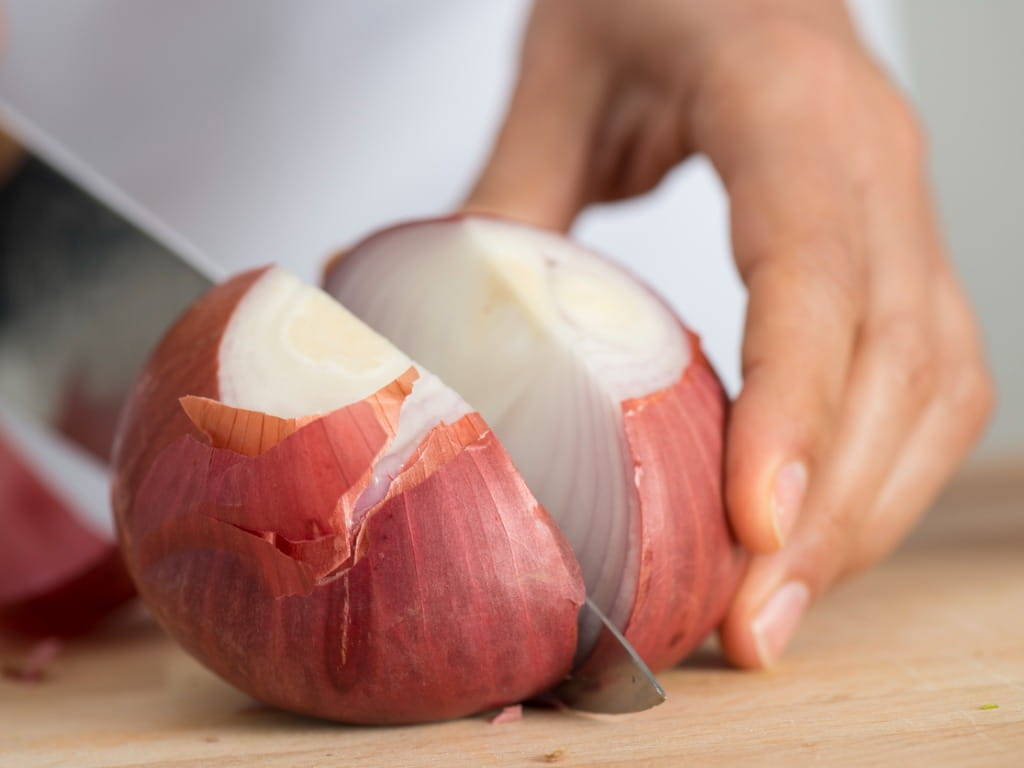Why Do Onions Make You Cry?

The Bottom Line
Onions are pungent, contain plentiful nutrients, and have many potential health benefits. When cut or damaged, onions can cause eye irritation and tear production due to the formation of a sulfur-containing chemical (called “lachrymatory factor”).

All about onions
The Allium genus of plants includes approximately 500 species, such as garlic, shallots, leeks, chives, scallions, and onions. The onion (Allium cepa) is one of the most popular vegetables worldwide. About 85 million tons of onions are grown each year, with the highest number of plants cultivated in China and India. The onion plant likely originated in central Asia but is now also grown throughout Europe, Africa, and North America. The city of Chicago, once known for growing large amounts of onions, is named after a Native American word that described the characteristic odor of onions.
What’s in an onion?
Onions are classified by their color (yellow, red, or white) and whether they are sweet or non-sweet. Regardless of their color or taste, onions are composed of mostly water (89%). Onions also contain carbohydrates (9%), protein (1%), vitamin C, manganese, as well as thiamine and other B vitamins. Onions contain small amounts of sulfur compounds and flavonoids that are responsible for the potential health benefits and unique characteristics associated with the plant.
Are onions good for you?
Flavonoids are plant chemicals that have important nutritional and therapeutic roles in humans. Common flavonoids found in onions include anthocyanins (found in red and purple onions) and quercetin (found in yellow onions). These compounds have many reported health benefits, including anticancer, anti-inflammatory, antimicrobial, and antidiabetic activities. Red onions contain the most flavonoids, followed by yellow and white onions. While storage does not appear to alter flavonoid levels in onions, frying them decreases their flavonoid content. However, other culinary practices such as boiling, steaming, and microwaving do not significantly affect the flavonoid content of onions. While onions are associated with beneficial health effects in humans, they are poisonous to some animal species. Dogs and cats can develop anemia, bloody urine, and lethargy after eating onions.
What gives onions their flavor?
Sulfur compounds are responsible for the distinctive flavor of onions. While intact onions have little flavor or aroma, sulfur compounds that are present within the onion plant undergo chemical reactions once an onion is damaged. When onions are damaged (such as when they are peeled, cooked, or cut), an enzyme called alliinase is released from the injured cells. The alliinase enzyme then breaks down the sulfur compounds into other chemicals, including sulfenic acids, pyruvic acid, and ammonia. These chemicals contribute to the characteristic flavors of onions. Other factors, including soil sulfur content, growing temperature, and water supply during plant growth, can also affect the intensity of onion flavor.
Why does cutting onions make you cry?
One of the best-known features of onions is their ability to cause eye irritation and tearing (lacrimation). Tearing is caused by the formation of propanethial-S-oxide, also known as lachrymatory factor. This lachrymatory factor is specific to onions, is not found in garlic, and is formed when alliinase breaks down a particular sulfur compound called 1-propenylsulfenic acid. There are only three lachrymatory factors found in nature, and all are produced by plants. Besides onions, lachrymatory factors are produced by Petriveria alliacea (a shrub that grows widely in South and Central America) and Allium siculum (sometimes call honey garlic)
How to reduce crying while cutting onions
There are many suggested tips for avoiding the pungency and tear-inducing properties of onions. These include lighting a match, wearing sealed goggles, or cutting onions while they are submerged in water. To reduce tearing when cutting onions, the National Onion Association recommends chilling them for 30 minutes prior to cutting and leaving the root end of the onion intact, as it contains the highest concentration of sulfur compounds. Additionally, since the sulfur content of the soil can affect the pungency of the vegetable, some onions are grown in low-sulfur environments. These “low-pungency” onions now account for up to a quarter of the onions consumed in the U.S. each year. However, due to their higher water content, low-pungency onions are more perishable than traditional onions. Scientists have also explored whether lachrymatory factor can be eliminated in onions through the use of genetic engineering. For now, however, there is no foolproof way to avoid crying when cutting onions.
For questions about strange or unwanted reactions to foods, contact Poison Control for expert advice. Help from Poison Control is available at www.poison.org and by phone at 1-800-222-1222. Both options are free, confidential, and available 24 hours a day.
Kelly Johnson-Arbor, MD
Medical Toxicologist
Poisoned?
Call 1-800-222-1222 or
Prevention Tips
-
Always wash your hands before, during, and after handling onions to avoid the spread of germs, as onions have been associated with Salmonella outbreaks.
-
Store onions in a cool and dry environment with plenty of ventilation.
-
Do not allow pets, including dogs and cats, to eat onions.
This Really Happened
Forty-two diabetic patients were given a glucose solution, water, insulin, or 100 grams of fresh onion slices in a clinical trial studying the effect of onion on blood glucose concentrations. As expected, the patients who were given insulin experienced decreases in their blood glucose concentrations. The patients who consumed fresh onion slices also had reductions in their blood glucose concentrations, suggesting that onions have an effect on glucose control (from Taj Eldin et al., 2010).For More Information
Frequently asked questions. National Onion Association. Accessed August 13, 2023.
Klein J. Why onions make you cry. New York Times. September 5, 2017. Accessed August 13, 2023.
References
Ascenzi P, Azzi A. Can onions be engineered for not tearing? IUBMB Life. 2003;55(1):49-50.
Cortinovis C, Caloni F. Household food items toxic to dogs and cats. Front Vet Sci. 2016;3:26.
Upadhyay RK. Nutritional and therapeutic potential of allium vegetables. J Nutr Ther. 2017;6:18-37.
Poisoned?
Call 1-800-222-1222 or
Prevention Tips
-
Always wash your hands before, during, and after handling onions to avoid the spread of germs, as onions have been associated with Salmonella outbreaks.
-
Store onions in a cool and dry environment with plenty of ventilation.
-
Do not allow pets, including dogs and cats, to eat onions.
